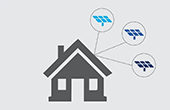Turnkey system, blends with roof, offsets all my energy use including one EV charging at home. Do your homework on installers and take your time to get multiple quotes. Prices are falling so don't get rushed into a decision. Own your solar so you reap all the benefits.
$3,454
100%
or more of electricity
$11,780
62.0%
Property
- Owner:
- Mark B
- Type:
- Single-Family Residence
- Address:
- , CA
- Size:
- 1,980 sq ft
- Energy need met:
- 100% or more of electricity
Technology
- Type:
- Solar PV
- Installed:
- June 2019
- Size of System:
- 6 kW
- Purposes:
- To generate electricity
Financial Details
- Gross Cost of System:
- $16,828
- Value of Tax Credits:
- $5,048
- Net Cost of System:
- $11,780
- Annual Savings:
- $3,454
- Annual Revenue:
- $3,851
- Own or Lease:
- Cash Purchase
- Additional Financial Notes:
- Installer offered financing through Wheelhouse Credit Union 8 year term at 4.99% but I elected to pay in cash. No monthly payments and no interest charges--I own the system so I get the full 30% tax credit which significantly reduces the overall system cost.
Professionals & Suppliers
- Installers:
- Sungenia Solar Solutions
What You Need to Know
Description:
6 Kw system. 20 X Silfab Solar SLA300M, black PV panels, 20 X SolarEdge P320 Power Optimizers, 1 X SolarEdge SE7600H-US Inverter. Includes online monitoring via SolarEdge portal with support for apps on iPad and iPhone to monitor performance down to each individual panel.
Other Benefits:
Offsets all electrical energy use plus charging requirements for one EV. Grid tied net metering provides monthly credit for excess energy generation. With monthly credits I use the electric utility as my virtual storage system allowing me to draw energy from the grid at night when my solar is not producing so I don't need a battery storage solution to benefit from my excess energy generation during daylight hours. Significantly reduced my carbon footprint on the environment.
Maintenance Requirements:
Only had the system for a month. I expect to clean the panels by spraying them with garden hose once every 3 months to keep the dust and pollen buildup under control. No other maintenance required so far.
Efficiency or Sustainability Improvements:
Added a NEMA 14-50 outlet on a 50amp circuit in the garage to charge the EV at home. I schedule the EV to charge at night during super off peak TOU rate window. One time cost $250 for electrician and parts. Installed a whole house fan to cycle the air in the house and reduce use of central AC system--this cools the house down every night with only an hour of low speed run-time and uses much less energy than the central AC system.
My Motivation:
San Diego has some of the highest electricity rates in the country. SDG&E is imposing TOU rates on all customers starting this year. The sun shines a lot in San Diego. The federal 30% tax credit available for PV installations begins to phase out starting next year. Energy cost will only go up every year. The cost of solar is much lower than I expected when I began to research and compare costs. Doing the math it worked in my favor--I expect the system will pay for itself within 4-5 years.
Advice:
Look at the last 12 months of your electric bills and first decide if you really need solar. Depending on where you live and how high your local electricity rate you might benefit from installing a solar system. You may find you don't need a large system to offset all or most of your annual energy use. Don't oversize your system. Make sure you can benefit from net metering by running the numbers based on expected power generation and your rate plan since this is how you can virtually store excess energy generation and use it from the grid when the sun is not shining. Get multiple quotes from installers and select a reputable company with good history of happy customers who will be around after your install to support you even if they cost a bit more. Take advantage of tax credits and/or rebates and include those in your cost model. It may surprise you how much less the system really costs factoring in available tax credits and rebates. If you are going with grid tied system you don't need a battery unless one of your requirements is having power available during blackouts. All the battery options I researched were too expensive to recover the cost of the battery inside the battery warranty period. This may change in the future--you can easily add battery storage later if you need to when the cost of batteries comes down.
Experience with Installer:
I used energysage to get quotes and looked at 6 quotes in total. I selected a smaller company called Sungenia Solar Solutions local to me where I could see a history of positive feedback from other customers. I am very impressed with their service from start to finish. The whole process took about 2 months from quote to design refinements to installation and PTO (permission to operate from the utility company). The system looks great on the roof and it's generating all the power as specified in the quote.
View Other Case Studies
Search for Other Case StudiesThe EnergySage Marketplace








